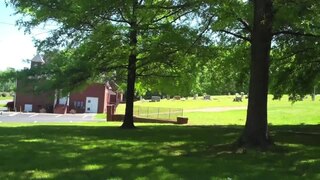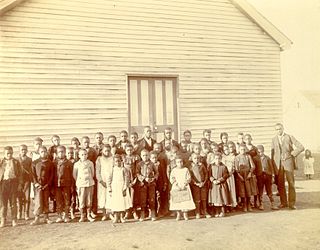
The Rosenwald School project built more than 5,000 schools, shops, and teacher homes in the United States primarily for the education of African-American children in the South during the early 20th century. The project was the product of the partnership of Julius Rosenwald, a Jewish-American clothier who became part-owner and president of Sears, Roebuck and Company and the African-American leader, educator, and philanthropist Booker T. Washington, who was president of the Tuskegee Institute.

Moggerhanger House is a Grade I-listed country house in Moggerhanger, Bedfordshire, England, designed by the eminent architect John Soane. The house is owned by a Christian charity, Harvest Vision, and the Moggerhanger House Preservation Trust, and has recently undergone a £7m refurbishment project with help from organisations such as the Heritage Lottery Fund, English Heritage, World Monuments Fund and the East of England Development Agency.

Durham's Chapel School, also known as Durham's Chapel Rosenwald School, is a former school for African-American children located in Gallatin, Tennessee, that is listed on the National Register of Historic Places.

Alvin C. York Institute, also known as Alvin C. York Agricultural Institute or York Institute, is a public high school in Jamestown, Tennessee, founded as a private agricultural school in 1926 by World War I hero Alvin York and later transferred to the state of Tennessee in 1937, which continues to operate it as a public high school. It is the only comprehensive secondary school in the United States that is financed and operated by a state government.

Bledsoe Creek State Park is a state park in Sumner County, Tennessee, in the southeastern United States. The park consists of 169 acres (0.68 km2) managed by the Tennessee Department of Environment and Conservation. The park spans much of the west shore of the Bledsoe Creek embayment of Old Hickory Lake, an impoundment of the Cumberland River created with the completion of Old Hickory Dam by the U.S. Army Corps of Engineers in 1954.

Liberty Colored High School is a former high school for African-American students in Liberty, South Carolina during the period of racial segregation. It originally was called Liberty Colored Junior High School. The building is now a community center known as the Rosewood Center. It is at East Main Street and Rosewood Street in Liberty. The school was built in 1937 on the site of a Rosenwald school that had burned down.

The Beauregard Parish Training School in DeRidder, Louisiana, was a school for black students and black teachers in training. The two school buildings, located on the original property at the corner of Martin Luther King Drive and Alexandria Street, were the first African-American related structures in southwestern Louisiana to be listed in the National Register of Historic Places, on March 1, 1996.
Guildfield Missionary Baptist Church is a historic African-American church on Guildfield Church Road in South Guthrie, Tennessee.

The Pleasant Hill School at 2722 Farm Rd. 1399 in Linden in Cass County, Texas was a Rosenwald School built in 1925 to serve African-American children. It has elements of Bungalow/craftsman style. It was listed on the National Register of Historic Places in 2004.
Cairo is an unincorporated community in Sumner County, Tennessee.

Cadentown School in Lexington, Kentucky was a primary public school for black children in the segregated Fayette County Public Schools from about 1879 to 1922. The building that originally housed Cadentown School, located at 705 Caden Lane, is no longer extant. However, the Rosenwald Fund School is listed on the National Register of Historic Places in Fayette County.

Lincoln School, also known as the Lincoln Consolidated Rosenwald School, is a former African-American school in Pikeville, Tennessee, that is listed on the National Register of Historic Places.

The Oak Grove Rosenwald School is a historic school building on Oak Grove Road in Oak Grove, a small settlement in southeastern Sevier County, Arkansas. It is a single-story wood-frame structure, built in 1926 with financial assistance from the Rosenwald Fund. It has two classrooms, and is based on a standard plan developed by Samuel Smith, an agent for the Rosenwald Fund, for this type of small community school. It was probably used for the education of local African Americans until the state's schools were integrated, and is the only surviving Rosenwald school in the county.

The Kiblah School is a historic school building in rural Miller County, Arkansas. It is located southeast of Doddridge, at the junction of County Roads 4 and 192, between United States Route 71 and the Red River. The building is a single-story L-shaped wood-frame structure, topped by a gable-on-hip roof. It has modest Craftsman styling, with some Greek Revival influences. The main entrance is sheltered by a hip-roofed porch supported by Craftsman-style columns. It has a transom window reminiscent of Greek Revival doorways. The school was built in 1927 with funding from the Rosenwald Fund, and was intended to serve the African-American community of Kiblah, which was established after the American Civil War by former slaves from a Louisiana plantation.

The Marley Neck Rosenwald School is a historic school building located at 7780 Solley Road in Glen Burnie, Maryland. It is a single story wood-frame structure measuring 68 by 20 feet, with a gable roof. The school was built in 1927 with design and funding assistance from the Rosenwald Fund, and served the area's African-American students. Out of the original twenty three built, it is one of the ten surviving Rosenwald schools in the county.

Hopewell School, also known as the Hopewell-Rosenwald School, is a former African American school in Cedar Creek, Texas, that was listed on the National Register of Historic Places on July 15, 2015. The school was built in 1921–1922 with assistance from the Rosenwald Fund. The school opened in 1922 and closed in the late 1950s.

Washington Graded School is a historic school located in Rappahannock County, Virginia. It was constructed around 1923 as a two-teacher school. The building is a "Rosenwald School". Rosenwald schools refer to those buildings constructed for the education of African-American students, with financial support and plans provided by the Rosenwald Fund. Julius Rosenwald, a Chicago philanthropist and president of Sears, Roebuck and Company, along with Booker T. Washington, the principal of Tuskegee Institute, worked with Black communities across the south to build more than 5,000 schools for Black children. Built in 79 localities in Virginia, about half shared the Washington School two-teacher design. The Washington School, which closed in 1963, retains the early look and feel of its rural setting, and exhibits historic integrity of design, workmanship, and materials.

Carroll Rosenwald School is a historical school building located at Rock Hill, York County, South Carolina.
Okahumpka Rosenwald School is a historic Rosenwald School building in rural Okahumpka, Florida, United States. It was built in 1929 and was used as a school for African American children in the community. It is one of the two remaining Rosenwald Schools in Lake County Florida.


















